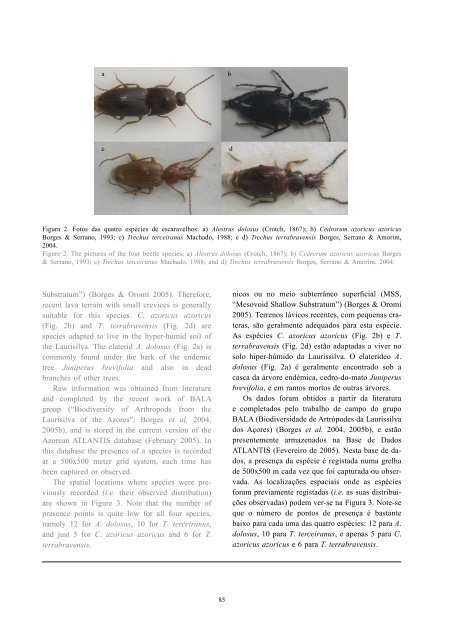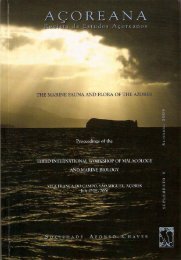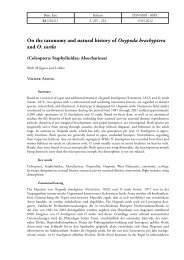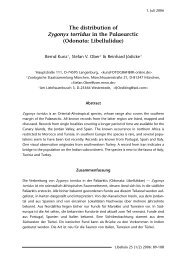(eds.) (2005). - Portal da Biodiversidade dos Açores - Universidade ...
(eds.) (2005). - Portal da Biodiversidade dos Açores - Universidade ...
(eds.) (2005). - Portal da Biodiversidade dos Açores - Universidade ...
You also want an ePaper? Increase the reach of your titles
YUMPU automatically turns print PDFs into web optimized ePapers that Google loves.
a b<br />
c d<br />
Figura 2. Fotos <strong>da</strong>s quatro espécies de escaravelhos: a) Alestrus dolosus (Crotch, 1867); b) Cedrorum azoricus azoricus<br />
Borges & Serrano, 1993; c) Trechus terceiranus Machado, 1988; e d) Trechus terrabravensis Borges, Serrano & Amorim,<br />
2004.<br />
Figure 2. The pictures of the four beetle species: a) Alestrus dolosus (Crotch, 1867); b) Cedrorum azoricus azoricus Borges<br />
& Serrano, 1993; c) Trechus terceiranus Machado, 1988; and d) Trechus terrabravensis Borges, Serrano & Amorim, 2004.<br />
Substratum”) (Borges & Oromí <strong>2005</strong>). Therefore,<br />
recent lava terrain with small crevices is generally<br />
suitable for this species. C. azoricus azoricus<br />
(Fig. 2b) and T. terrabravensis (Fig. 2d) are<br />
species a<strong>da</strong>pted to live in the hyper-humid soil of<br />
the Laurisilva. The elaterid A. dolosus (Fig. 2a) is<br />
commonly found under the bark of the endemic<br />
tree Juniperus brevifolia and also in dead<br />
branches of other trees.<br />
Raw information was obtained from literature<br />
and completed by the recent work of BALA<br />
group (“Biodiversity of Arthropods from the<br />
Laurisilva of the Azores”; Borges et al. 2004,<br />
<strong>2005</strong>b), and is stored in the current version of the<br />
Azorean ATLANTIS <strong>da</strong>tabase (February <strong>2005</strong>). In<br />
this <strong>da</strong>tabase the presence of a species is recorded<br />
at a 500x500 meter grid system, each time has<br />
been captured or observed.<br />
The spatial locations where species were previously<br />
recorded (i.e. their observed distribution)<br />
are shown in Figure 3. Note that the number of<br />
presence points is quite low for all four species,<br />
namely 12 for A. dolosus, 10 for T. terceiranus,<br />
and just 5 for C. azoricus azoricus and 6 for T.<br />
terrabravensis.<br />
85<br />
nicos ou no meio subterrâneo superficial (MSS,<br />
“Mesovoid Shallow Substratum”) (Borges & Oromí<br />
<strong>2005</strong>). Terrenos lávicos recentes, com pequenas crateras,<br />
são geralmente adequa<strong>dos</strong> para esta espécie.<br />
As espécies C. azoricus azoricus (Fig. 2b) e T.<br />
terrabravensis (Fig. 2d) estão a<strong>da</strong>pta<strong>da</strong>s a viver no<br />
solo hiper-húmido <strong>da</strong> Laurissilva. O elaterídeo A.<br />
dolosus (Fig. 2a) é geralmente encontrado sob a<br />
casca <strong>da</strong> árvore endémica, cedro-do-mato Juniperus<br />
brevifolia, e em ramos mortos de outras árvores.<br />
Os <strong>da</strong><strong>dos</strong> foram obti<strong>dos</strong> a partir <strong>da</strong> literatura<br />
e completa<strong>dos</strong> pelo trabalho de campo do grupo<br />
BALA (Biodiversi<strong>da</strong>de de Artrópodes <strong>da</strong> Laurissilva<br />
<strong>dos</strong> <strong>Açores</strong>) (Borges et al. 2004, <strong>2005</strong>b), e estão<br />
presentemente armazena<strong>dos</strong> na Base de Da<strong>dos</strong><br />
ATLANTIS (Fevereiro de <strong>2005</strong>). Nesta base de <strong>da</strong><strong>dos</strong>,<br />
a presença <strong>da</strong> espécie é regista<strong>da</strong> numa grelha<br />
de 500x500 m ca<strong>da</strong> vez que foi captura<strong>da</strong> ou observa<strong>da</strong>.<br />
As localizações espaciais onde as espécies<br />
foram previamente regista<strong>da</strong>s (i.e. as suas distribuições<br />
observa<strong>da</strong>s) podem ver-se na Figura 3. Note-se<br />
que o número de pontos de presença é bastante<br />
baixo para ca<strong>da</strong> uma <strong>da</strong>s quatro espécies: 12 para A.<br />
dolosus, 10 para T. terceiranus, e apenas 5 para C.<br />
azoricus azoricus e 6 para T. terrabravensis.

















